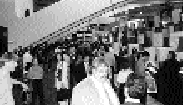
By Jeffrey Bartlett
One of the by-products of attending a major conference and trade show year in and year out is that it enables you to measure change. UniForum annually offers such a comparison of progress in the area of Unix and open systems. This year, calls for a "return to our roots" added an interesting twist to the unstoppable momentum of large-scale computing.
Several prominent speakers felt that the intimate relation between Unix and open systems has been obscured recently, and they tried to correct some misperceptions. The rallying cry was sounded first and strongest by Michael Tilson, current UniForum president and CIO of the Santa Cruz Operation. "The term 'open' has been hijacked," he said in remarks preceding the opening day keynote speech. "Because 'open' is good, everyone labels whatever they sell as 'open.'" Tilson pointed to Microsoft as "the most egregious example" of this misappropriation. He went on to reassert the historic and technical associations of the term in the IT industry and promised, while implicitly giving advice to the Unix sector of the industry, that UniForum will not be "afraid to speak the 'U word': Unix."
Three of the keynote speakers were on the same page as Tilson. Lew Platt, Hewlett-Packard CEO; Louis Gerstner, IBM CEO; and Alok Mohan, SCO CEO, all stressed that Unix has changed the face of computing and tied Unix systems to the "network-centric" focus of today's "business-critical" applications. Gerstner's declaration of faith brought a smile to some of us who remember when IBM was synonymous with proprietary.
Only Scott McNealy, Sun Microsystems CEO, did not spend much time pledging renewed allegiance to Unix, though he, too, credited the Unix community with driving "the networked age" now blossoming. McNealy focused on the World Wide Web and managed to sneak in a product demo of the Java-based "zero-administration client" Sun plans to sell. "Hardware is gonna be cool again," he said afterward. That afternoon, Eric Schmidt, Sun CTO, used the same demo in his plenary. If HP and SCO led the events of Wednesday, Sun took the center stage on Thursday. (Full reports on all the keynote addresses and plenary sessions follow in this issue.)
Observations by our editorial staff and conversations with conference speakers and attendees revealed pervasive concerns on a series of issues that could be grouped under the heading of systems management. Managers as well as actual IS administrators cited these areas in particular: security; performance tuning; WAN management; and data access. Conference sessions on these topics were among the best attended. Even if there were no other worries (and of course there are many of those), this list would keep IS teams working overtime until next year's conference.
Speaking of hot spots, a subsidiary event during the preconference drew surprising turnout: Tuesday's "Evening with Plan 9." More than 500 IT aficionados came to hear about this distributed operating system (and possible successor to Unix) from Dennis Ritchie, a leader of both projects. The reputations of Ritchie and Bell Labs still are magnetic.
On the trade show floor, two other eye-catching venues drew crowds and comments. The "Generations" display of computers in the Data General booth, featuring exhibits from the Computer Museum of Boston and the Intel Museum, showed how far the industry has come in 20 or 30 years. Enterprise Live, a pavilion created by consultants Cambridge Technology Partners, offered a tour of the three-tier architecture of a mythical manufacturer called Clockworks. CTP took this virtual company from concept to show floor in less than six weeks, a project manager said.
An hour after this announcement on Wednesday morning, just before the opening keynote address, the capacity crowd heard a long-time proponent of industry collaboration receive due recognition. Jim Bell, who has been on loan from HP to OSF as its interim CEO, received the UniForum Achievement Award for 1996. Several of his peers from other companies afterward characterized Jim, who also serves on the UniForum board of directors, as a "statesman" for the way he promotes the cause of open systems in a pragmatic manner, always looking for consensus. His selection for the award, which recognizes sustained contributions, was a popular one.
Now that it's all over, everyone can get back to work on turning technologies into solutions that address problems in the real world. Soon enough we'll be counting the changes from this year to next. Planning for the 1997 conference begins on May 1.